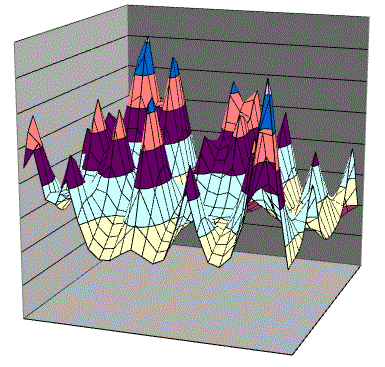Two paradigms for managing uncertainty
Once upon a time, the best practices for manufacturing, supply chain management, project management and product development were predict-and-plan approaches. Managers developed detailed models of their processes, estimated and forecasted key variables and created plans via mathematical optimization techniques.
An example is materials resource planning (MRP) for scheduling production in a factory. With MRP software, managers modeled a factory, forecasted demand, and via optimization, produced production plans that fulfilled orders while minimizing production costs and lead times.
How well did MRP's predict-and-plan approach perform? MRP caused chaos in factories, increasing costs, lengthening cycle-times and decimating quality. Managers initially responded by doubling down on the predict-and-plan approach, via MRP2 software. They modeled more details of their factories, forecasted more variables, more forcefully imposed their plans on workers and "re-optimized" their plans more frequently. The results were the same: uncontrollable processes, higher costs, increasing lateness and abysmal quality. The predict-and-plan approach produced similarly harmful results for supply chains, project management and product development.
Eventually, managers replaced the predict-and-plan approach with a new paradigm. By managing uncertainty better they reduced the frequency and severity of decision errors, which made processes flexible. These new, flexible approaches remade manufacturing, supply chains, project management and product development, and these approaches were so successful their names are well-known: just-in-time, theory of constraints, flexible supply chains, agile and lean.
The two paradigms are succinctly described as follows:
- Predict-and-plan: One models the structure of a decision situation, striving to mimic it, estimates the model's parameters via forecasting, and via complex algorithms, optimizes decisions. Uncertainty is a secondary consideration, addressed by performing a sensitivity analysis via the model.
- Managing uncertainty better: The new paradigm organizes processes to reduce the frequency and severity of decision errors, which increases flexibility. The structure of a situation is a secondary consideration, since reducing the cost of decision errors often requires simplifying processes, ignoring some qualities of a situation (structure), while ignoring some information as well.
You can learn more about the two paradigms from my paper:
 Summers, G. J. and C. M. Scherpereel,
"Decision-making in
product development: are you outside-in or inside-out?" Management Decision,
vol. 46, no. 9, 2008, pp. 1299-1312.
Summers, G. J. and C. M. Scherpereel,
"Decision-making in
product development: are you outside-in or inside-out?" Management Decision,
vol. 46, no. 9, 2008, pp. 1299-1312.
As an immediate introduction, here are some highlights from the paper:
| Predict-and-Plan | Managing Uncertainty Better |
|---|---|
| Build models and make decisions with the model. | Build decision-making into processes. |
| Make decisions outside of the system. | Keep decisions inside the system. |
| Seek perfection: optimize. | Seek consistency: eliminate errors. |
| Embrace complexity. | Simplify. |
| Fix mistakes by re-planning. | Eliminate mistakes. |
| Consider many variables. | Consider fewer variables and fewer choices. |
| Maximize or minimize criteria (expected value, profit, costs, cycle-time). | Increase flexibility. |
Manufacturing, supply chain management, project management and product development strive to reduce the frequency and severity of decision errors, but project portfolio management (PPM) still practices the predict-and-plan approach. Why? There are two reasons:
- PPM's theoretical foundation, which is decision theory, is just begining to theorize about unknown-unknowns, such as black swan events, and how such uncertainty affects decision methods. (To learn about recent advances in decision theory, see my discussion, "The difference between theory and practice: its disappearing.")
- PPM provides managers with too little feedback, so identifying and fixing errors is difficult. (See my discussion, "Where's the feedback?")
Fortunately, the situation is changing. The new research in decision science is providing a theoretical foundation for advancing PPM, while machine learning is testing decision methods and evaluating their results (feedback). Some of the studies compare simpler decision methods to more sophisticated ones, addressing a long-standing debate in PPM.
I am applying this new knowledge to PPM, pipeline management (phase-gate systems) and drug development. The result is a burgeoning new framework called pipeline physics. You can learn about pipeline physics from my papers:
- How to make drug development more productive.
- Managing drug development pipelines.
- Pipeline physics research proposal. (Contact me for the password needed to view the proposal.)
Here are some highlights of pipeline physics.
| Pipeline Physics | PPM's Best Practices |
|---|---|
| Increase the value flowing through and out of your pipeline (dynamic model). | Maximize portfolio value (static model). |
| Managing uncertainty is paramount. | Modeling the structure of your situation is paramount. Managing uncertainty is a secondary consideration, performed via sensitivity analysis. |
| The front-end is the most significant part of your pipeline, affecting everything downstream. | Project selection is the most significant step for creating value. |
| Most value is created by resolving undertainty. | Most value is created by selecting projects to maximize value. |
| Pull approach: downstream goals guide upstream decisions. | Push approach: pour "optimal" portfolios into your pipeline. |
| Manage the flow of value. | Plan and re-plan, via successive portfolio optimizations. |
After reading my discussions, many managers wish to share their experiences, thoughts and critiques of my ideas. I always welcome and reply to their comments.
Please share your thoughts with me by using form below. I will send reply to you via email. If you prefer to be contacted by phone, fax or postal mail, please send your comments via my contact page.
© 2014 Pipeline Physics. All rights reserved.

